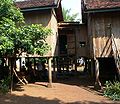
Khmer architecture, also known as Angkorian architecture, is the architecture produced by the Khmers during the Angkor period of the Khmer Empire from approximately the later half of the 8th century CE to the first half of the 15th century CE.

A barn is an agricultural building usually on farms and used for various purposes. In North America, a barn refers to structures that house livestock, including cattle and horses, as well as equipment and fodder, and often grain. As a result, the term barn is often qualified e.g. tobacco barn, dairy barn, cow house, sheep barn, potato barn. In the British Isles, the term barn is restricted mainly to storage structures for unthreshed cereals and fodder, the terms byre or shippon being applied to cow shelters, whereas horses are kept in buildings known as stables. In mainland Europe, however, barns were often part of integrated structures known as byre-dwellings. In addition, barns may be used for equipment storage, as a covered workplace, and for activities such as threshing.

Timber framing and "post-and-beam" construction are traditional methods of building with heavy timbers, creating structures using squared-off and carefully fitted and joined timbers with joints secured by large wooden pegs. If the structural frame of load-bearing timber is left exposed on the exterior of the building it may be referred to as half-timbered, and in many cases the infill between timbers will be used for decorative effect. The country most known for this kind of architecture is Germany, where timber-framed houses are spread all over the country.

Framing, in construction, is the fitting together of pieces to give a structure support and shape. Framing materials are usually wood, engineered wood, or structural steel. The alternative to framed construction is generally called mass wall construction, where horizontal layers of stacked materials such as log building, masonry, rammed earth, adobe, etc. are used without framing.
A tie, strap, tie rod, eyebar, guy-wire, suspension cables, or wire ropes, are examples of linear structural components designed to resist tension. It is the opposite of a strut or column, which is designed to resist compression. Ties may be made of any tension resisting material.

Rumah Gadang or Rumah Bagonjong "house for the Minangkabau people" are the traditional homes of the Minangkabau in West Sumatra, Indonesia. The architecture, construction, internal and external decoration, and the functions of the house reflect the culture and values of the Minangkabau. A Rumah Gadang serves as a residence, a hall for family meetings, and for ceremonial activities. In the matrilineal Minangkabau society, the Rumah Gadang is owned by the women of the family who live there; ownership is passed from mother to daughter.
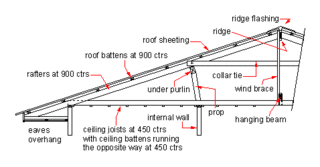
Domestic roof construction is the framing and roof covering which is found on most detached houses in cold and temperate climates. Such roofs are built with mostly timber, take a number of different shapes, and are covered with a variety of materials.

The bahay kubo, kubo, or payag is a type of stilt house indigenous to the Philippines. It often serves as an icon of Philippine culture. The house is exclusive to the lowland population of unified Spanish conquered territories. Its design heavily influenced the Spanish colonial-era bahay na bato architecture.
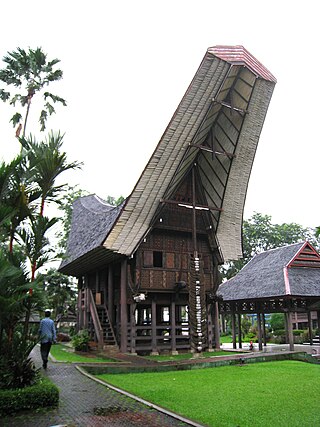
Tongkonan is the traditional ancestral house, or rumah adat of the Torajan people, in South Sulawesi, Indonesia. Tongkonan has a distinguishing boat-shaped and oversized saddleback roof. Like most of the Indonesia's Austronesian-based traditional architectures, tongkonan are built on piles. The construction of tongkonan is a laborious work and it is usually built with the help of all family members or friends. In the original Toraja society, only nobles had the right to build tongkonan. Commoners live in smaller and less decorated homes called banua.

A rice barn is a type of barn used worldwide for the storage and drying of harvested rice. The barns' designs are usually specialized to their function, and as such may vary between countries or between provinces. Rice barns in Southeast Asia appear quite different from rice barns found in other parts of the rice cultivating world. In the United States rice barns were once common throughout the state of South Carolina.

Batak architecture refers to the related architectural traditions and designs of the various Batak peoples of North Sumatra, Indonesia. Six groups of Batak speak separate but related languages: the Angkola, the Mandailing to the south, the Toba, to the north the Pakpak/Dairi, the Simalungun, and the Karo. While the groups are now Muslim or Christian, elements of the ancient Batak religion remain, particularly amongst the Karo.

Rumah adat are traditional houses built in any of the vernacular architecture styles of Indonesia, collectively belonging to the Austronesian architecture. The traditional houses and settlements of the several hundreds ethnic groups of Indonesia are extremely varied and all have their own specific history. It is the Indonesian variants of the whole Austronesian architecture found all over places where Austronesian people inhabited from the Pacific to Madagascar each having their own history, culture and style.

American historic carpentry is the historic methods with which wooden buildings were built in what is now the United States since European settlement. A number of methods were used to form the wooden walls and the types of structural carpentry are often defined by the wall, floor, and roof construction such as log, timber framed, balloon framed, or stacked plank. Some types of historic houses are called plank houses but plank house has several meanings which are discussed below. Roofs were almost always framed with wood, sometimes with timber roof trusses. Stone and brick buildings also have some wood framing for floors, interior walls and roofs.

Choga is a term for traditional Korean houses (hanok) with thatched roofing. The main building materials used to build these houses are straw, wood and soil.
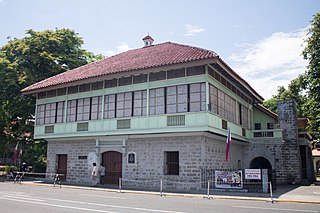
Bahay na bato, also known in Cebuano as balay na bato or balay nga bato and in Spanish as casa Filipino, is a type of building originating during the Spanish colonial period of the Philippines. It is an updated version of the traditional bahay kubo of the Christianized lowlanders, known for its use of masonry in its construction, using stone and brick materials and later synthetic concrete, rather than just full organic materials of the former style. Its design has evolved throughout the ages, but still maintains the bahay kubo's architectural principle, which is adapted to the tropical climate, stormy season, and earthquake-prone environment of the whole archipelago of the Philippines, and fuses it with the influence of Spanish colonizers and Chinese traders. It is one of the many architecture throughout the Spanish Empire known as Arquitectura mestiza. The style is a hybrid of Austronesian, Spanish, and Chinese; and later, with early 20th-century American architecture, supporting the fact that the Philippines is a result of these cultures mixing. Its most common appearance features an elevated, overhanging wooden upper story standing on wooden posts in a rectangular arrangement as a foundation. The posts are placed behind Spanish-style solid stone blocks or bricks, giving the impression of a first floor. Still, the ground level contains storage rooms, cellars, shops, or other business-related functions. The second floor is the elevated residential apartment, as it is with the bahay kubo. The roof materials are either tiled or thatched with nipa, sago palm, or cogon, with later 19th-century designs featuring galvanization. Roof styles are traditionally high pitched and include the gable roof, hip roof, East Asian hip roof, and the simpler East Asian hip-and-gable roof. Horses for carriages are housed in stables called caballerizas.
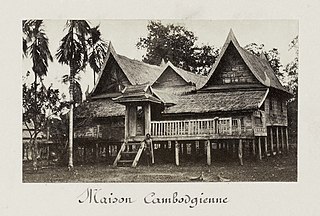
The Traditional Khmer Housing refers to the construction and assigned usage of houses or buildings by the Khmer people since the ancient time and evolved until today. In Cambodia, there are many Khmer style houses that are built in different ways depending on hierarchy and purposes. In special terms, the house is a symbol of prosperity in the national society, and it serves the lives of the people in each village, which is culture and nature The Khmer has long been known to traditionally live on different designs of stilt house and also has a multi-leveled floor and gable finials at both ends of the roof ridge.
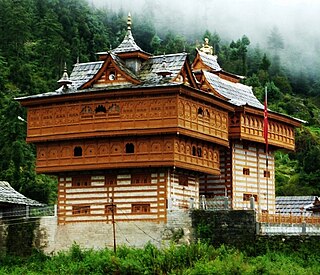
Kath-Kuni is an indigenous construction technique prevalent in the isolated hills of northern India, especially in the region of Himachal Pradesh Kath is derived from the Sanskrit word kashth meaning wood and kuni from the word kona meaning corner. It also goes by other names such as kath-kona, kath-ki-kanni in Sarahan region
A Dai bamboo house is a type of stilt building primarily constructed of bamboo as the traditional form of housing for Dai people. The lower floor was about seven or eight feet high. Horses and oxen were hitched to the posts. There was a terrace near the upper stairs, which turned into a large long room. The rest of the house was a largely open space with a low roof, sloping on both sides, with eaves to the floor and, generally, no windows. If the eaves were slightly higher, there were small windows on both sides and a door on the back. In the middle of the building was a fireplace, burning day and night. The roof was covered with thatch and the doors and windows are made of bamboo. The construction is easy. It only took a few days to cut down bamboo and gather neighbors together to build it. These houses are perishable and had to be repaired each year after the rainy season. This construction method was conducive to damp roof, and drainage of rain suitable for topography of the PingBa area.

Architecture Of Saudi Arabia was not different in the pre-oil era during the early 1930s from what it was across the past centuries. Construction and building activities followed a simple and modest style back then, as there was a lack of specialized architects in the modern sense. Instead, native communities would erect their own structures manually through the efforts of builders using basic means and local materials in what came to be known as “traditional architecture.” Every region in Saudi Arabia was famous for its own brand of architecture that expressed its artistic taste. Building materials used at that time were sourced from the local environment, such as clay, rock, palm fronds, and wood. Similarly, the architectural styles passed on from generation to generation reflected each region's climatic and environmental conditions.
The Vann Molyvann House is a major landmark of the city of Phnom Penh built in 1966 by Khmer architect Vann Molyvann as his private house and architecture office. It has been dubbed as the "Cambodian Taliesin" and praised as a "testimony to the unique ability of Southeast Asia's greatest living architect to fuse European modernism with traditional Khmer design in an apparently seamless style."
























































